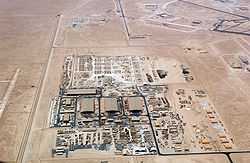RAF Al Udeid
| RAF Al Udeid | |||||||
|---|---|---|---|---|---|---|---|
| قاعدة العديد الجوية | |||||||
| Near Doha in Qatar | |||||||
 | |||||||
 RAF Al Udeid Shown within Qatar | |||||||
| Coordinates | 25°07′02″N 051°18′53″E / 25.11722°N 51.31472°ECoordinates: 25°07′02″N 051°18′53″E / 25.11722°N 51.31472°E | ||||||
| Type | Royal Air Force station | ||||||
| Site information | |||||||
| Owner | Qatar Emiri Air Force | ||||||
| Operator | Royal Air Force | ||||||
| Site history | |||||||
| Built | 2005 | ||||||
| In use | 2005-Present | ||||||
| Airfield information | |||||||
| Identifiers | IATA: XJD, ICAO: OTBH | ||||||
| Elevation | 40 metres (131 ft) AMSL | ||||||
| |||||||
| Source: DAFIF[1][2] | |||||||
Royal Air Force Al Udeid or more simply RAF Al Udeid is a Royal Air Force station located at Al Udeid Air Base which itself is located 17 miles (27 km) south west of Doha in Qatar. The facility served as a station for British air operations in support of Operation Telic and Operation Herrick - the designation for British operations in Iraq and Afghanistan respectively.
As of 2014, the air base is being used as a headquarters for British forces involved in Operation Shader, the UK's military intervention against ISIS in Iraq.[3]
History
Fighter aircraft
A detachment of between 6 and 8 Tornado GR4 aircraft and nearly 400 personnel was once stationed at the base. The aircraft were equipped with a range of stores, including the Vicon Recce Pod, LITENING targeting pod, 1000 lb HE bombs, Paveway II and Paveway III laser-guided bombs, and the RAPTOR Recce Pod. Of the personnel detached to RAF Al Udeid, approximately 130 were direct aircraft engineers, with the remaining 270 being in the support and operation management role.
Squadron personnel were on a two-month rotation at RAF Al Udeid with the remainder of the force on a four-month rotation. Support personnel were on varying rotations but not as often generally as the squadron personnel.
The aircraft assigned to RAF Al Udeid were drawn from across the Royal Air Force Tornado GR4 fleet and were chosen for their currency and up-to-date modification state. The aircraft were not from any particular squadron but pooled from RAF Marham and RAF Lossiemouth aircraft.
The RAF operated from what was known as the "Southern QRA" buildings. Aircraft were housed in canvas shelters to protect them and the personnel working on them from the heat of the sun.
The Tornado detachment ended in June 2009, with the aircraft being deployed elsewhere.[4]
Transport aircraft
From 2005, Vickers VC10s operated by No. 101 Squadron RAF were based at RAF Al Udeid.[4] The detachment ended during Summer 2009.[4]
RAF Al Udeid was used as a staging post for personnel en route to Iraq (in particular, Basrah) with personnel transferring from passenger aircraft, such as the RAF-operated Tristar and VC10, to the tactical transport Lockheed C-130 Hercules. The Hercules transit was in the region of two hours and mostly in tactical black-out conditions.
Current use
The air base is currently being used as a headquarters for the British Armed Forces involved in Operation Shader, the UK's military intervention against ISIS in Iraq.[3] The Royal Air Force has also stationed an RC-135 Rivet Joint signals intelligence aircraft at the base to operate over Iraq and Syria.[5]
See also
References
- ↑ Airport information for OTBH from DAFIF (effective October 2006)
- ↑ Airport information for IUD at Great Circle Mapper. Source: DAFIF (effective Oct. 2006).
- ↑ 3.0 3.1 "UK and Qatar sign pact to combat jihadis and cyber warfare". ft.com. 2 November 2014. Retrieved 13 December 2014.
It is also headquarters to the UK’s campaign against Isis, Operation Shader.
- ↑ 4.0 4.1 4.2 "19 Years Over Iraq". The Official RAF Annual Review 2010 (Stamford: Key Publishing): p. 12. December 2010.
- ↑ "RAF prepares jets to strike Isis targets in Iraq". The Guardian. 23 September 2014. Retrieved 13 December 2014.
An RAF Rivet Joint surveillance plane equipped with listening devices has also been flying missions from al-Udeid air base in Qatar to eavesdrop on Isis communications.